There are three main types of vanilla available for purchase, and I’d often wondered the similarities and differences among them. If you’re like me, hopefully this post will help identify the different types of vanilla.
The differences are pretty subtle, but they are there. Once you decide which is your favorite–or you decide to make your own vanilla extract exactly the way you want it, you can use it to flavor everything from creme brulee to whipped cream pound cake to the best hot fudge sauce.
This post is part of my ingredient function series, and all those posts are neatly housed in the Ingredient Function section. Let’s jump in.
Pastry Chef Online Participates in Affiliate Programs. If you make a purchase through one of my links, I may earn a small commission. For more information click to read my disclosure policy
The Magic of Vanilla
I am always amazed when people use the word vanilla as an adjective to describe something or someone who is plain, boring or lackluster.
Vanilla is one of the most complex flavors around, containing upwards of 200 different flavor compounds.
Due to the labor-intensive nature of its cultivation, harvest and processing, vanilla is also second only to saffron in cost, and the price has risen quite a bit over the last few years due to difficult growing conditions, shipping cost, and more.
While it is true that the majority of what we think of as the “smell” or “taste” or vanilla comes from vanillin, there are tons of other compounds that serve to round out and add nuance to the flavor.
Imitation Vanilla
Imitation vanilla, on the other hand, is composed almost entirely of one flavor note: vanillin. That’s why imitation vanilla is both less subtle and less complex than true vanilla derived from vanilla beans.
From now on, if you want to describe something or someone as being plain, boring or lackluster, please use the term vanillin.
Is “Clear Vanilla” Imitation Vanilla?
Clear vanilla is definitely imitation vanilla, so it is pretty much straight up vanillin. Clear vanilla is useful when you want vanilla flavor but you still want your icing to be bright white.
Real vanilla is almost always brown, and using a scraped vanilla bean will give you little specks in your frosting, so for a super white vanilla-flavored icing, clear vanilla is the only way to go.
Why Compare the Different Types of Vanilla?
Recently, I purchased three different vanilla extracts:
- Madagascar Bourbon
- Mexican
- Tahitian.
I was curious to try them in a head-to-head taste test since I had some preconceived notions of which type of vanilla was “best” without really ever trying all of them for myself.
In the restaurants, we used Madagascar Bourbon Vanilla pastes and extracts.
I’ve used Mexican vanilla beans before in pudding, and I love the woody mysteriousness of it, and although I adore Sonoma Syrup’s Vanilla Bean “Crush” (a blend of Madagascar Bourbon and Tahitian vanilla), I’d never had Tahitian vanilla on its own.
Now I had the opportunity to try all three vanillas, side by side. (Some vanilla is produced in both Indonesia and India, but I haven’t come across it before. If I can find some, I’ll give them a whirl, too).
This vanilla is so fragrant and so gorgeous, y'all. I love it in anything where vanilla really needs to shine, like creme brulee, excellent vanilla ice cream, or creme Anglaise. This is the good stuff you break out when vanilla is the star of the show.
My Preconceived Ideas About the Types of Vanilla
- Madagascar Bourbon vanilla is the gold standard of vanillas.
- Mexican vanilla extract is kind of shady, although the beans are great.
- Tahitian vanilla is mostly about aroma, not actual flavor.
- The differences among the three types of vanilla will be readily apparent.
Note that these preconceptions did not necessarily all hold up after tasting.
Vanilla Taste Test
If I were conducting a scientific experiment, I would have had a “control group” that didn’t contain any vanilla at all, but I wasn’t, so I didn’t.
Here’s what I did to conduct my vanilla taste test:
- I smelled and tasted the vanillas straight.
- I smelled and tasted them diluted in water.
- I smelled and tasted them in whole milk.
- I smelled and tasted them in vanilla pudding (stirring in the extracts off the heat).
- I smelled and tasted them in vanilla shortbread (baking the extracts in, this time)
If I’d had a control group, I would have just tasted straight milk and made pudding and cookies without any vanilla in them at all.
But I’m only human and there are only so many glasses of milk One can drink and cookies and pudding that One can eat!
A Note on the Madagascar Bourbon Vanilla I Used
I also need to note that the Madagascar Bourbon vanilla I have is paste, which aside from vanilla extract also contains sugar, vanilla beans, gum tragacanth and a small amount (0.1%) of potassium sorbate as a preservative.
To try and keep the tests as fair as possible, I used a bit more of the paste and tried really hard not to pay attention to the sweetness.
Nielsen Massey's vanilla paste is rich, sweet, and thick. A little goes a long way, so use it sparingly. I especially like it in ice cream, creme brulee, and panna cotta: desserts where flecks of vanilla bean enhance the visual appeal of the dish.
Vanilla Tasting Notes
Tasting the Extracts “Straight”
To me, concentrated vanilla extract smells kind of like Play-Doh.
Then someone commented here that Play-Doh smells like vanilla and not the other way around. Of course!
I hope I’m not the only one. Having said that, the Madagascar Bourbon and Tahitian vanillas both smelled very similar to me. Both have an aroma that is subtle, sweet, and spicy, although the Tahitian smelled a bit sweeter to me.
The Mexican vanilla has a few deeper notes. It’s a bit more woody and earthy; a bit mysterious. It smells like Mysterious Play-Doh.
Flavor-wise, the Madagascar Bourbon tastes most like “standard vanilla” to me while I tasted the Tahitian more in the air in my mouth rather than on my tongue.
That tells me that the Tahitian is more about aroma and less about actual taste. Or rather the flavor is carried more by the aroma, if that makes sense.
The bass notes (bass as in low on the scale, not as in fish) in the Mexican vanilla translated to more bass flavor as well. It’s a bit hard to describe, but the Mexican vanilla has more “dark wood” flavor than the other two.
Smelling the Aroma in Water
Just like Bourbon and Scotch open up when just a few drops of water are added, I wanted to smell and taste the vanilla in water as well.
Rather than adding a few drops of water to each vanilla, I added 1/4 teaspoon of vanilla to each of three 2 oz glasses of filtered water. After all, vanilla is pretty expensive!
Here’s what I found:
- I could barely smell the Madagascar Bourbon vanilla in the water, even with my nose right down in the glass.
- The Tahitian had a very apparent, sweet and vanilla-y aroma
- The Mexican vanilla was almost as hard to detect as the Madagascar Bourbon vanilla was.
Tasting the Vanilla in Water
I also tasted the water, and the same results as the “straight up” tasting played out more subtly in this test:
- the Madagascar and Tahitian both tasted of sweet vanilla, although the flavor was more “in the air” for the Tahitian.
- The Mexican vanilla also had a sweet vanilla flavor supported by that extra woody note.
Tasting in Whole Milk
More than any of the other tests, the milk test really highlighted the differences among the three vanillas.
Would you like to save this post?
I’m not sure whether it was because of the fat in the milk or the proteins or the milk sugars, but whatever it is about milk, it really helps make obvious the differences in aroma and flavor.
- The milk with the Madagascar vanilla in it both smelled and tasted like melted Philadelphia-style (no egg) ice cream. It was kind of amazing, really.
- The Tahitian vanilla milk smelled sweetly of vanilla, but again the flavor was mostly in the air in my mouth and not actually on my tongue.
- The Mexican vanilla milk smelled fairly strongly of alcohol, which I thought was odd since there was only 1/4 teaspoon of vanilla in 2 oz of milk. I couldn’t really taste the vanilla in the milk at all–it just tasted like milk, but more so. Like the best milk ever, but not necessarily vanilla.
Maybe the vanilla flavor of Mexican vanilla has a creaminess to it that allows it to blend in to enhance and not overpower??
Tasting the 3 Vanillas In Vanilla Pudding
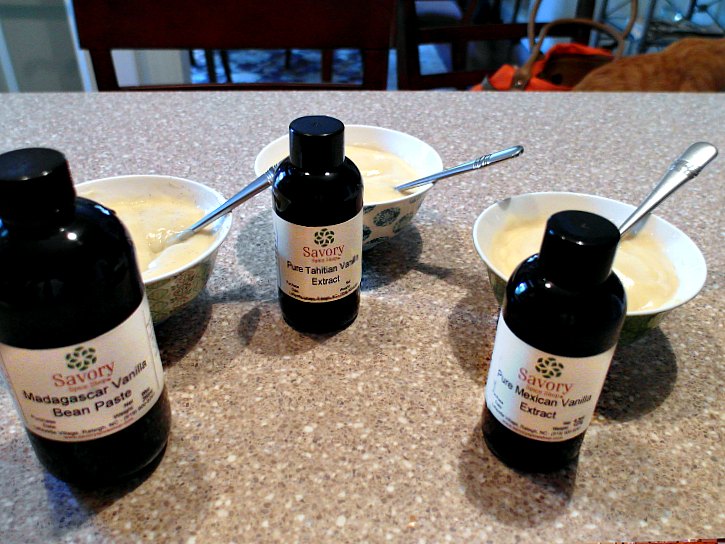
I made my standard vanilla pudding containing whole milk, sugar, corn starch, egg yolk and salt (see video). I normally add butter, but not this time.
I also added a smidge more salt than I normally would to really make the vanilla flavor pop. Don’t worry–it wasn’t a salty, or even savory pudding. It was just really good and well seasoned.
Making Vanilla Pudding Video
I divided the pudding into thirds and stirred in the extracts off the heat: 1/2 teaspoon per 6 oz of pudding base, and I tasted the puddings both hot, warm and cold. Because I live to serve.
The puddings all smelled fairly distinctive when hot and warm:
- The Madagascar smelled of sweet, spicy vanilla.
- The Tahitian was a bit headier but just as sweets
- The Mexican smelled like vanilla, only deeper–woody.
All three tasted of sweet vanilla, but again, the Tahitian was more “in the air” than the Madagascar, and the Mexican was deeper.
My favorite of the three was the Mexican, but I want to stress that I might not have been able to detect a difference at all if all three weren’t in front of me at one time. Here is my vanilla pudding recipe using Mexican vanilla.
When chilled, the differences became much less obvious, with the Madagascar tasting like standard (excellent) vanilla pudding, the Tahitian pretty much just tasting like pudding with a hint of vanilla, and the Mexican tasting a bit more complex and deep than the other two.
Again, the differences here are subtle.
In Shortbread
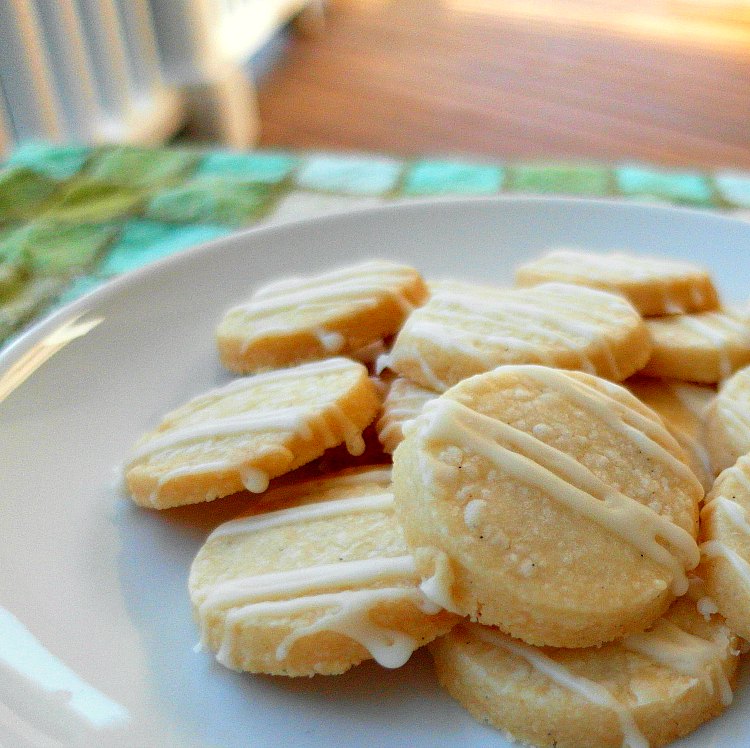
This might have been the most surprising of the “tests” I ran.
Here’s what I did:
- I made a batch of Chris’s (from Café Sucré Farine) vanilla bean shortbread
- I divided the creamed butter, powdered sugar and salt among three bowls, mixing in the vanillas and then the flour/corn starch mixture by hand.
- I added 1/2 teaspoon of vanilla to what ended up being about 7 oz of dough per batch.
Honestly, I could detect almost no difference among the three batches of cookies. When warm, and even when cool, the Tahitian batch had more of a vanilla aroma–sweetly vanilla–than the other two, but flavor-wise I really couldn’t taste the difference. I tried, too. Often. Heh.
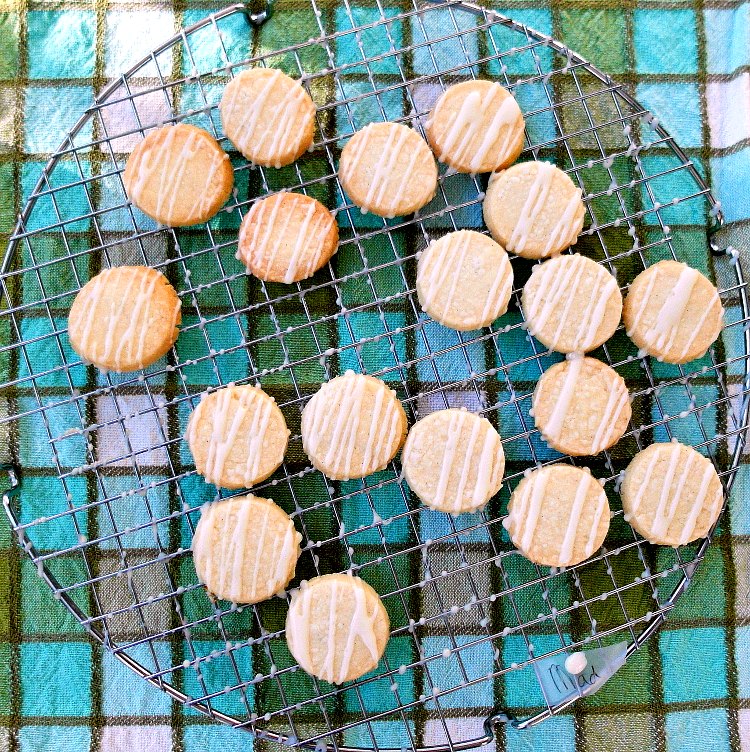
I really do wish that I had made a plain batch of cookies to test against since I really couldn’t taste the differences at all.
Making Homemade Vanilla Extract with Different Types of Vanilla Beans
The good news about making your own vanilla extract is that you can use all the types of vanilla beans to make one Super Complex Vanilla Extract.
You can of course make your extract out of all of one type of bean, but why not have fun and make custom blends? Use a combination of Madagascar and Mexican beans. Or Madagascar and Tahitian. Have fun with it!
How Many Beans to Use In Your Extract
I like my vanilla to be very strong so I can use less, so I tend to use 6 beans per 8 oz of alcohol. I used 2 each of Madagascar, Mexican and Tahitian beans.
You can get away with using 4 beans per 8 ounces of alcohol, but the flavor won’t be quite as concentrated.
How to Make Vanilla Extract
Making vanilla is very easy. NOTE: Some say you can’t make a true vanilla extract at home and that homemade is actually an infusion. Honestly, I don’t care either way. Homemade extract/vanilla infusion is delicious, and if it brings you joy to make it and/or give it as gifts, go for it!
- Buy vanilla beans. Cut a slit in each bean to have vanilla specks in your extract or leave them whole if you don’t want specks.
- Add your vanilla beans to a clean jar with a tight-fitting lid.
- Fill the jar with your choice of alcohol. You can use vodka, rum, or Bourbon whisky. (NOTE: the “Bourbon” in Madagascar Bourbon Vanilla has nothing to do with Bourbon whisky. Rather, Bourbon is a nod to French Colonial times and refers to any vanilla grown around the Indian Ocean.)
- Wait. Your vanilla will be ready in 4-6 weeks. Shake your jar once or twice a week (not truly necessary, but it will make you feel like you’re doing something besides waiting)
NOTE: Store your vanilla in a cool, dark place like a cabinet or pantry. It will last pretty much indefinitely, and you can top off your extract with more alcohol and throw an extra bean or two in every year or so.
Why Some Mexican Vanilla is “Shady”
The reason I thought Mexican vanilla extract is shady is because some of it is. (And here’s where I get sad for Mexico again).
Once folks began growing vanilla outside of Mexico and figured out how to pollinate it, Mexico pretty much got squeezed out of the vanilla business.
To try to compete. they started selling artificial/imitation vanilla and added extract of tonka bean to it.
Tonka bean extract smells and tastes like Extreme Vanilla, but apparently it has also been shown to damage the livers of lab animals, so the FDA banned it in the US.
If you buy Mexican vanilla and it is super-cheap (like $5 for a liter or something), it is probably flavored with tonka bean.
The good news is that it tastes kind of awesome. The bad news is that it’s illegal in the US and might damage your liver (although I think you’d pretty much have to drink it like soda for it to be harmful).
Real Mexican vanilla tastes super awesome, but it’s not cheap. The cost is pretty much on par with Madagascar and Tahitian extracts.
If you want to try some excellent Mexican vanilla, go with the Blue Cattle Truck Trading Company, based in the US, they source all their beans from a small farm in Mexico. This is the real deal, friends, and worth buying. Use it to make Mexican flan or to flavor the flan layer in chocoflan. You won't regret it!
Vanilla Taste Test of the Different Types of Vanilla: The Take-Aways
- The differences among the three types of vanilla are very subtle, although I do think that Tahitian alone isn’t worth using in baking or cooking, unless you’re making perfume. The Sonoma Syrups folks have it right, I think: mix Madagascar Bourbon and Tahitian vanillas for both a well-rounded vanilla flavor and a vanilla-forward aroma. If you happen to own some Vanilla Bean Crush, try mixing it with the Mexican vanilla, too. I’ll probably do that on my own, and if the combination is life-changing, I will let you know.
- Buy real vanilla, made from vanilla beans. Artificial vanilla is really too one-note and rather bull-in-a-china-shop-ish. It’s clumsy vanilla. For vanilla flavor, I really don’t think you can go wrong with either Madagascar Bourbon or the Mexican. Yes, the Mexican is a touch deeper and more mysterious, but again, the difference is fairly subtle and you might not even be able to tell the two apart if you don’t have them side by side.
- At the end of the day, really only one of my preconceived notions held up: Tahitian vanilla is all about the aroma. Not that it doesn’t also taste good–it has a lovely, floral flavor. As to Madagascar Vanilla being the gold standard of vanillas, all I have to say about that is that is that the beans (and their natural pollinators) originated in Mexico.
And that is pretty much all I have to say about that. I hope you find this post useful and if you’ve ever wondered about the differences among different types of vanilla, now you know.
Questions?
If you have any questions about this post or recipe, I am happy to help.
Simply leave a comment here and I will get back to you soon. I also invite you to ask question in my Facebook group, Fearless Kitchen Fun.
If your question is more pressing, please feel free to email me. I should be back in touch ASAP, as long as I’m not asleep.

Hi, y’all! I hope you’ve enjoyed this post and hopefully also learned a thing or two.
If you like my style, I invite you to sign up for my occasional newsletter, The Inbox Pastry Chef.
Expect updates on new and tasty recipes as well as a bit of behind-the-scenes action. I hope to see you there!



Join in Today!
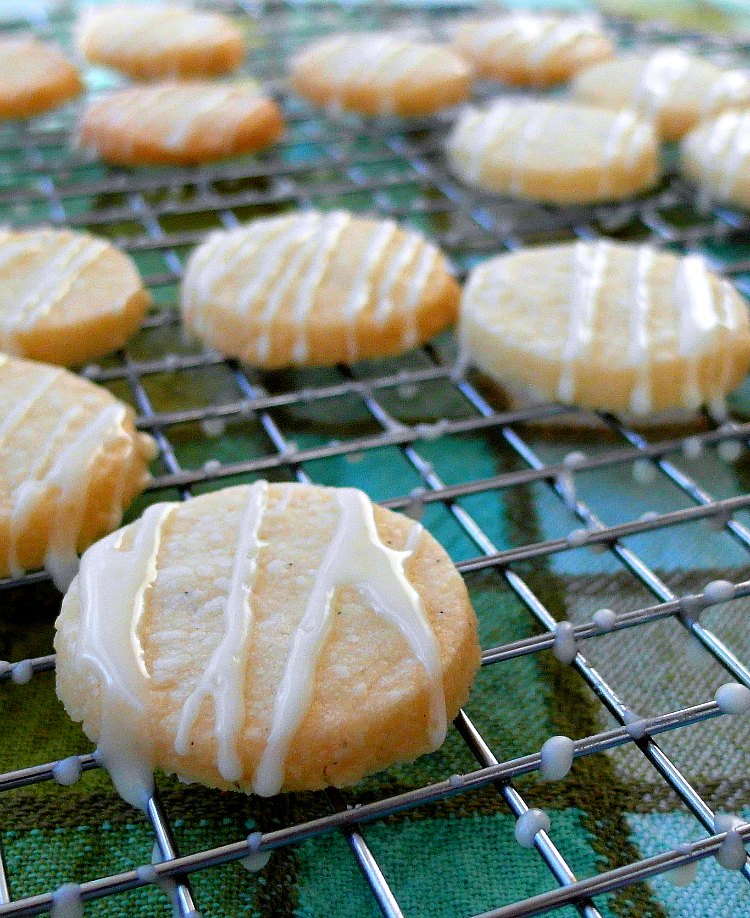


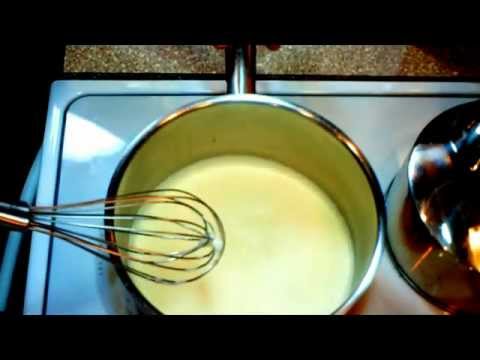


Thanks. I sincerely appreciate the information.
My pleasure, Lydia! I’m glad you found it useful!
I bought a vanilla pod for the first time (from Madagascar) and when I opened the package it smelled *just* like Play Dough! I thought it was rubbed down with some wax or something. Interesting that you think vanilla extract smells like play-dough as well…
Cool experiment, but the additives in the Madagascar vanilla make it very inaccurate IMO. The added sugar and other ingredients undoubtedly affect the taste/flavor/depth/etc.
Hi, Abbey! Thanks so much for stopping in. I always appreciate comments!
You’re correct that I used Madagascar vanilla bean paste versus regular extracts of Tahitian and Mexican, and in a straight up taste test, I will admit that it might be a bit like comparing apples and oranges. However, once dispersed in a recipe in a small amount, I think the comparison still works just fine since the other two were in mixes that also contained extra sugar (the pudding and the cookies, at least). If I were doing a scientific experiment, then I of course would have made sure to use the same form of all three. But in the context of a blog post, I’m confident that my results represent the similarities and differences among the three and that they would hold up if I tried this again using three extracts.
That Sonoma Syrups Vanilla Bean Crush (still my favorite, 2 1/2 years later) smells freakishly of Play-Doh! =)
This was a great article! Usually, as much as I love hitting food blogs for recipes, the long-winded, over-drawn stories about the recipes are a major turn-off. However, you made your post absolutely informative, very interesting, and just really cool to read- and for that I am grateful! You totally opened my mind up about vanilla- I have baked for fun since childhood, did 5 years of culinary in high school, and totally adore food. I am rather picky about reading about food, and you do it well! Thanks so much for a great article! 🙂
You just made my day, Natty, and I haven’t even had my coffee yet! I love writing articles like this, and you can find lots under the Fundamental Fridays and What Can I Do For You Wednesdays posts as well as in the top tab under “Fundamentals.” I really appreciate your comment and I’m so glad you enjoyed the article! Have a wonderful day!
Thank you for your post! I learned a lot! I use vanilla extract from Mexico. I bought a bottle for a niece and my husband said ‘vanilla from Tahiti is better.’ Uh, and how do you know that? In 68 he (a teen) was in Tahiti with the family and they went to a plantation that made it. He says he can still smell it which proves your point….it has quite an aroma. LOL! I googled ‘the comparison’ and found your post! The town where I live in Oregon has a med size Hispanic community so the grocery stores carry a large selection of Hispanic goods. That’s where I buy my vanilla! It truly is amazing!
Wow–I bet a Tahitian vanilla plantation smells incredible! I really am partial to Mexican vanilla, although I do like to use a blend for general baking and cooking. I have some Sonoma Syrups Vanilla Bean Crush that is my current favorite: a mix of Tahitian and Madagascar. Lovely! So glad you stopped in, Peggy!
Thanks!! =)
To whom it may concern, three contenders I am mulling over:
http://shop.lorannoils.com/candy/super-strength-flavors/1-ounce-and-larger-sizes/pumpkin-flavor
http://vapingunderground.com/threads/smug-juice-naturally-extracted-pumpkin-flavor-of-the-month.22351/
http://www.suttonsbaytrading.com/pumpkin-flavor.html
Two of them are identified as “candy oil” (whatever one can glean from this description?).
P.S. Has you ever been commended, Ms. Jennifer Field, on the swiftness with which you not only accept your reader’s posts but immediately leave a thoughtful response? This particular page/article is over a year old (though the most recently prior my post, just a few weeks), yet you replied to my comment in just 20mins!! o_0
Candy oil (I think) means that it won’t lose its flavor at high heats (250F+) I do try to be as timely as possible in responding to comments, Victor. Sometimes I do better than others!
I own a LorAnn lemon oil that tastes like Pledge, so be aware of that. Not sure what that means for the pumpkin flavor… lol
I’ll check out these links; I appreciate your posting them!
Riveting read! Now I want to get aholda some ‘Mexican’ vanilla beans (after first getting a french press for coffee & cocoa beans, hehh).
My primary baking goal right now involves acquiescing some legitimate extract, flavor, or essential oils (or perhaps even imitation flavoring[s] if the taste/aroma seems spot-on or sufficiently close thereto) from\of the flesh (not seeds) of pumpkins—specifically, those types of squash used in pumpkin pies or canned pumpkin purée. (Obviously the flesh consistency of the derived squash for this purpose does not matter, although presumably the application of high heat could destroy certain molecular compounds responsible for its final taste albeit probably not from internal temperatures reached during the normal process of baking).
The difficulty in this lies in the fact that *pumpkin pie* extracts and the like are abound (even though many are falsely labeled simply as “pumpkin [extract]”. So far I have identified one product on Amazon.com that has been reviewed to the tune of anything other than “pumpkin pie”, and another maybe (from a vendor which I shall phone tomorrow).
(In case you’re wondering, I intend on using this initially in a pumpkin pie recipe that I am perfecting).
Hi there, Victor! Glad you liked the article. Will be interesting to see if you can find anything that approaches the flavor of the pumpkin itself and not the spices that are usually associated with the “flavor” of pumpkin pie.
Would love to see/hear about your perfected pumpkin pie!
Hi Jenni! Thanks for the link. So happy you enjoyed these cookies. They look wonderful – I’d kind of forgotten about them. Now you’ve got me craving shortbread 🙂 Love your comparisons of vanillas, I had no idea about much of this!
When I was looking for cookie recipes to try out the different vanillas, yours came up on the first page, and I couldn’t *not* use it! Love them, Chris!
I absolutely loved this article, you’re hilarious. I used mexican vanilla, first time ever, last month and I can’t get enough of it. It tastes like there’s something else in it, not just vanilla. The kind I bought is Molinas, tested and fda approved no coumarin (or whatever it is) but made in Mexico. I’m hooked on it, I love the deeper darker flavor..even my girls noticed the difference in pancakes lol.
Thanks for sharing, I finally know it’s just as good as any other vanilla. Now if I can just remember where I bought it, I’d buy a whole case.
I’m so glad you enjoyed the article. Yes, I’m a Mexican vanilla Super Fan! Your girls have very good palates to be able to tell the difference in pancakes!d
Nice article.
Several years ago, Cook’s Illustrated did a comparison using real and artificial vanilla for different applications: something cold (icecream? not sure), yellow cake and a cookie. Their conclusion was that for baked goods that reach very high internal temperatures, many flavor compounds burn off and the fine nuances are lost. For cookies, shortbread and similar, the testers actually preferred artificial vanilla (I guess that should also be true for caramel sauce, since it gets stupidly hot during preparation). For ice creams/puddings/custards, no contest, real vanilla was miles ahead.
I could see how vanillin would stick around longer. Most of my baked goods only get to an internal temperature of around 200F, and I don’t consider that particularly high. With caramel though, I wait and add the vanilla after it has cooled down quite a bit. It’s a good thing we have those Cook’s Illustrated folks around–they never tire of testing!
Are these better than making your own extract with beans and bourbon?
I doubt that they are better, but they are probably more consistent, flavor-wise, Judi. I have a batch of homemade working right now that is a mix of all three beans in some cheap vodka. I might do a taste comparison just for fun. =)
First of all – fascinating! I knew there was a difference but have never read any true comparisons. Now I want to try it. I know here in Nantes I can actually find the vanilla beans from different places. I was also sent some vanilla beans from India a few years ago (am still using them) so that would be interesting, too.
Second – you are hysterical and make learning fun!
Third – I am now craving vanilla pudding.
Thanks for doing this in the name of science 😉
Well, someone had to do it! And now I want to get some of those Indian vanilla beans!
Someone asked “what kind of vanilla do they use to make vanilla extract?” Just plain old vanilla that isn’t necessarily labeled Madagascar Bourbon or Mexican or whatever. And I have no idea…
PS Vanilla pudding is the best. =)
This post is awesome — I am such huge fan of vanilla extract (especially all the different kinds), and this is totally something I would do. My husband and I really like the Tahitian vanilla, and I use it all the time for more “delicate” tasting things like whipped cream. For more robust flavor, though, I like to use madagascar or mexican. Thanks for sharing your results!
I’m so glad you enjoyed it! It was a lot of fun to do. I think vanilla is underrated–sounds like you agree!
Thank you Jenni for doing the legwork on this! I feel like I might be an undertaster or something because I never detected much of a difference between the three. (Also maybe because I think tuna fish salad and salami taste amazing on a sandwich). This is an incredible resource and I hope to see more! Would you consider doing one on cocoa powders? I’m in the Bensdorp camp, but lots of people swear by Valrhona.
I shall make no comment about tuna and salami on a sandwich. Enjoy your “Surf&Turf!” LOL
I will absolutely give this a whirl with cocoa powder, although there are so many to choose from! I will have to limit myself or things could get crazy!
You did some really good vanilla testing!! I am so grateful that you shared this with us. I had no idea what goes on behind the scenes of the vanilla industry. 🙁
These shortbread cookies are making me really really want one! (One dozen- just to clarify.)
Well after all, they are *small…!* I barely touched on vanilla production, but it does make some interesting reading!
This is so detailed and informative. Will you hate me if I say I buy whatever vanilla is on sale (real, not imitation)?
Of course not. =) Sales are good! lol